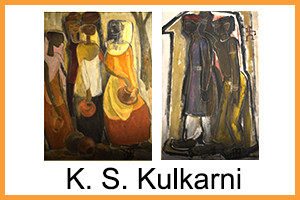
K.S. Kulkarni
By MANOHAR KAUL
Published in Roopa Lekha in 1985
After his sojourn abroad for over a decade, I had the privilege of meeting Prof. K.S. Kulkarni in his studio at Lalit Kala Akademi Studio at Garhi, New Delhi. I found him bubbling with energy despite his frail health. We had an interesting dialogue. He recounted his experiences abroad and told me how he remained busy holding his solo exhibitions in a number of countries. He said that through his exhibitions and lectures in many art institutions he was also able to project India and at the same time he himself achieved much by studying different art movements taking place there which, he says, had given him a "new vision." To translate this new vision onto canvas, Kulkarni is working hard and stays in his studio from morning hours till late in the evenings, unmindful of his failing health. He says that he could not afford to waste a single moment as the time was running out fast and he had yet much to achieve. He is filled with this passion and is sparing no pains to achieve his objective.
I was simply struck by the large number of works which he had executed during the last few years. He is prolific. There are a few thousand drawings, paintings and sculptures based on his varied experiences and influences he has imbibed from time to time. The drawings are composed in line and colour on canvas and paper. Metal and glass are not left out. The fact is that Kulkarni has not lost sight of any medium which has appealed to his imagination and has experimented with anything which he could find useful for his aesthetic expression. Kulkarni's creations are marked with simplicity and clarity; the lineal treatment adds movement and vibrancy.
With his eyes riveted on the rich heritage of his country, he roams freely in the wide world of modernity. With faith and confidence, Kulkarni has ransacked the Indian traditions from Ajanta to Pahari miniatures, from Konark to Khajuraho. At the same time, with a keen sense of observation and rich imagination, he has freely appropriated and assimilated healthy influences from the East and the West and even from far-off Mexico and the United States. In his earlier works, influences of Western masters, though visible, remained only a passing phase. The fact is that after having travelled extensively abroad his basic approach to art has not changed and he could retain his spiritual moorings which are deep-set in his personality.
In his works one is really fascinated to see how he has delineated the decorative elegance and the illusive line drawings from the frescoes of Ajanta and Ellora, lyrical freshness from Kangra art, and the varied and charming dimensions of Indian sculpture. I am reminded of Kulkarni's masterpiece entitled "Composition, 1957," which was a vigorous interpretation of the foreboding doom that awaited mankind as an apprehended consequence of the chaotic world tensions.
Kulkarni's style stands halfway between expressionism and abstraction. The figure drawings based on India's traditional art are full of dynamic vitality and delicate but powerful lineal stances.
In his latest drawings one perceives an exciting, powerful line and his colour application is stimulating and full of rhythm, which adds a lyrical quality of great charm. Using a masterly technique in dealing with numerous subjects and themes, Kulkarni's works converge on a beautiful synthesis of modern concepts and Indian tradition. His figures, though stylized, unmistakably take the viewer to the hoary past of India's rich cultural heritage. Of late, he is busy drawing inspiration from Indian mythology and epics.
The high-water mark of Kulkarni's work is spontaneous expression which comes to him with ease and his mastery over colour. He is one of our topmost colourists who has understood pigment in depth. He has experimented with varied colour schemes which blend harmoniously with his magic touch—a feat uncommon with most of our contemporaries. His figures and images, modelled on visual experience in India and abroad, seem to have their existence in the wide world, and yet retain his stamp of individuality, which is a remarkable feat. In spite of his being prolific and touching a vast variety of themes, his works are marked with a unifying and integrated composition which communicates with ease and creates instantaneous impact.
A mature and sensitive artist in the art of synthesis, Kulkarni is not only bound to give a lead to the younger generation of painters and sculptors in the country but his life and work can also be a source of inspiration as an artist with pure passion for creative expression.
They say that there is a limit to the physical capabilities of a Homo sapiens, but for Kulkarni sky is the limit. The artist has survived three heart attacks and is living with a chronic asthmatic condition. To top it all he became semi-blind in 1979 and was not able to recognise anyone. It was in 1982 that he managed, with difficulty, to undergo surgery in the United States which fortunately helped him regain his vision. These three years, he says, were a period of acute mental agony and torture as he was rendered helpless and could not pursue his vocation. He added, "I faced it with calm contemplation conjuring up visuals in my imagination as if I was really working. This exercise was satisfying."
